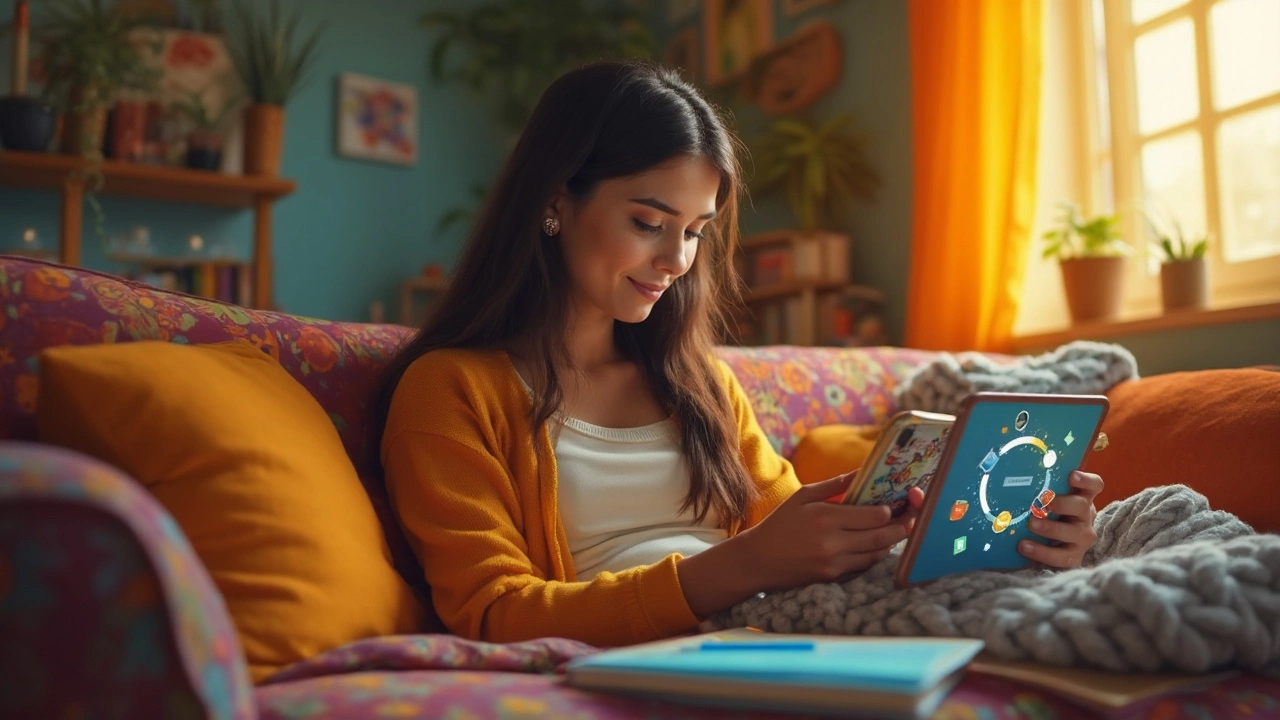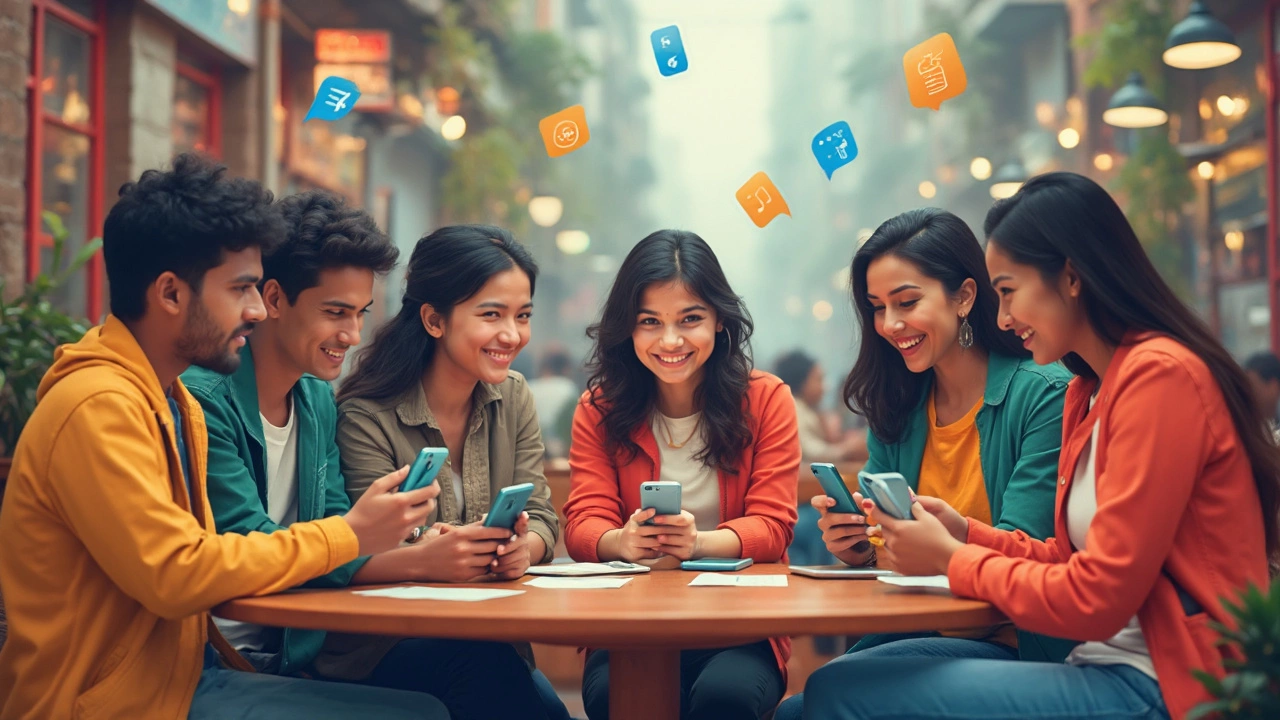
If you've ever watched a lesson while waiting for your coffee or crammed for a quiz in the back of an Uber, you're part of the mobile learning club. These days, your phone isn't just for memes and messages—it can handle full courses from big universities, interactive language apps, and skill videos too.
But can your phone really replace a laptop or classroom? Short answer: it depends on what you're learning and how you like to study. Phones are awesome for videos, quick quizzes, flashcards, and discussions. They slip in your pocket so you can knock out a lesson while waiting in line or during a commute.
There's a catch—some platforms feel cramped on a small screen, and tricky assignments (like coding or writing essays) can be a pain. Still, loads of apps are now designed to work perfectly on mobile. Big names like Coursera, Duolingo, and Khan Academy all come with solid phone support. Some even let you download material, so bad Wi-Fi won't leave you hanging mid-lesson.
Bottom line: your phone makes learning fit your life, not the other way around. Whether you're aiming to pick up a new skill, prep for an exam, or just kill time productively, eLearning on mobile is totally doable—if you know what to expect and how to make it work for you.
- Why Move Learning to Your Phone?
- What You Can Actually Do on a Phone
- Best Apps for Learning on the Go
- Tips for Staying Focused (and Sane)
- Common Roadblocks (and Workarounds)
- Is Learning by Phone Really Worth It?
Why Move Learning to Your Phone?
Phones are everywhere. According to a 2024 Pew Research Center survey, over 95% of people aged 18-35 have a smartphone within reach almost all day. That means your biggest study tool might already be in your pocket.
One huge reason to shift to mobile learning is flexibility. You don't need to haul around a laptop or be stuck at a desk. Got ten minutes on the subway or waiting at the dentist? That's more than enough time for a quick lesson, a quiz, or reviewing flashcards. Mobile learning lets you use those random chunks of time to actually get things done.
Another big plus: instant access. Maybe a question pops up while you're out—just pull out your phone and check the answer, or join a discussion. Notifications make sure you don't miss deadlines or updates, which really helps if you tend to forget things.
- eLearning on your phone uses way less data than you might think, especially if you download lessons over Wi-Fi ahead of time.
- Most platforms let you switch between your computer and phone. Start a lesson on your laptop at home, then pick up where you left off on your phone when you're on the move.
- For group projects, it’s way quicker to chat and share files on mobile apps than to wait until everyone’s at their computer.
Finally, learning on your phone puts you in control. You decide when, where, and what you study. That freedom just isn’t possible with traditional learning or courses that only work on a big screen.
What You Can Actually Do on a Phone
People often think a phone is just for scrolling or texting, but you can get actual eLearning done too—and not just the basics. Most big e-learning platforms have custom apps that let you watch video lectures, read course notes, do quizzes, and chat with other learners. You can even submit assignments, all on your phone.
Here's what your phone can handle for online learning:
- Watch Video Lessons: YouTube, Coursera, and Khan Academy are optimized for mobile. Videos load fast and you can adjust playback speed or add subtitles.
- Take Quick Quizzes: Apps like Quizlet and Duolingo use swipe gestures for flashcards and quick practice tests.
- Join Discussions: Course forum posts, group chats, and audio replies work smoothly in apps like Udemy and EdX.
- Read and Annotate Materials: PDF readers like Adobe or built-in browser readers let you open, highlight, and add notes to course material.
- Download Content for Offline Use: Many platforms let you download lectures, readings, or even quizzes for when your data runs out—or when you're on a spotty bus ride.
Ever tried writing a 1,000-word essay on a phone? It's rough. Small screens are not great for long-form writing, coding assignments, or spreadsheets. For these, a laptop is the way to go, but if you need to bang out a short post or upload a pic, your phone gets the job done.
Check out how students use their phones, based on a 2024 survey by Statista:
| Activity | % of Learners Using Phones |
|---|---|
| Watching video lectures | 78% |
| Practicing with quizzes/flashcards | 64% |
| Participating in discussions | 49% |
| Submitting assignments | 32% |
The takeaway? Your phone is perfect for quick learning boosts, staying updated, and getting small tasks done. For deep work—like research or complicated projects—nothing beats a bigger screen.
Best Apps for Learning on the Go
Not all eLearning platforms play nice with small screens. Some are built for mobile from the start, while others just try to cram their desktop site onto your phone. If you want a smooth experience, picking the right app matters a lot.
Let’s talk specifics. Duolingo is the go-to for anyone tackling a new language. The app has over 500 million downloads and keeps things light with quick, game-like lessons. For more serious academic stuff, Khan Academy covers everything from math basics to history, all packaged simply for your phone. The Coursera app lets you swipe through university-level courses, stream video lectures, and even earn certificates, directly from your device.
If you love step-by-step learning, try Skillshare or Udemy. Both offer video courses taught by real pros—think web design, photography, or even Excel tips. And for science and tech folks, you can’t beat edX, which hooks into big names like Harvard and MIT.
"Mobile learning is no longer a nice-to-have—it's a must-have for busy learners everywhere." — Lisa Nielsen, Director of Digital Engagement, NYC Department of Education
Need to stay ahead of your schedule or prep for tests? Quizlet makes flashcards simple and easy to swipe, and you can even find pre-made decks on just about anything. Google Classroom’s app helps students manage assignments, join classes, and chat with classmates, perfect if your school uses it.
Here’s a quick look at some of the most popular eLearning apps and what they do best:
| App | Best For | Offline Mode |
|---|---|---|
| Duolingo | Language Learning | Yes (some lessons) |
| Khan Academy | School Subjects | Yes |
| Coursera | College-Level Courses | Yes |
| Quizlet | Flashcards, Test Prep | Yes |
| Udemy | Skill Building | Yes |
| Skillshare | Creative Skills | Yes |
A cool tip: turn on offline mode for these apps before you travel or head somewhere with sketchy Wi-Fi. That way, your learning doesn’t stop just because your signal does.

Tips for Staying Focused (and Sane)
Studying on your phone is super handy, but wow, it’s easy to get sidetracked by a new notification or random scroll session. Here’s how people actually make it work—without losing their mind or wasting all their time on puppy reels.
- Turn off notifications before you start your session. One buzz from a group chat or a sale alert and you’re down a two-hour rabbit hole. Most phones let you swipe into "Do Not Disturb" mode in a second. Some students keep a “Focus” profile just for study time.
- Use dedicated study apps or browser modes. Apps like Forest or Focus Keeper give you mini rewards or track your streaks for staying off social media. Research from RescueTime found the average person checks their phone 58 times a day—so a nudge to stay on track helps.
- Work in short bursts. The Pomodoro technique (25 minutes of studying, five-minute break) isn’t just hype. Science backs it: Stanford research reports that breaks help your brain avoid burnout and keep your memory fresh.
- Grab a cheap phone stand. Holding your phone for an hour just feels awkward. With a stand, you can go hands-free and avoid neck strain. Even a mug and a rubber band will do the trick.
- Set a real deadline. Use your calendar to set hard stop times, and remind yourself what you want to finish. Having an end in sight actually makes you more productive—according to the American Psychological Association, people who set time limits get more done.
- Change up your spot. A little movement between sessions—plopping onto a different chair or chilling outside—can help you reset your focus and stave off boredom.
Check out this comparison table to see how these tips measure up based on real user feedback:
| Tip | % Reporting Focus Improvement | Extra Benefit |
|---|---|---|
| Turning Off Notifications | 72% | Less stress, fewer interruptions |
| Pomodoro Technique | 65% | Increased motivation |
| Dedicated Study Apps | 60% | Tracks time, builds habits |
| Changing Study Spot | 54% | Boosted creativity |
Bottom line: you’re not powerless against distractions. Making a few tweaks lets you use your phone for actual learning instead of, well, everything else. If you’re serious about eLearning on your phone, these small changes are game changers.
Common Roadblocks (and Workarounds)
Sure, your phone puts a whole classroom in your pocket, but let's not pretend it's flawless. There are real obstacles that can trip up mobile learning. The good news? Most can be worked around if you know what to expect and how to prep.
The tight screen is the first headache. Trying to read dense textbooks, zoom in on diagrams, or write long assignments on a phone can get old fast. One MIT survey found that 62% of students said small screen size hurt their focus and reading speed. If you feel cramped, use apps that break info into bite-sized chunks or let you adjust the text size. For bigger stuff, like complicated charts, save them and check on a laptop if one’s available.
Battery drain is another sneaky problem. Video lessons and interactive apps chew through power in no time. Here’s a quick look at average battery life by activity:
| Activity | Avg. Battery Life (Hours) |
|---|---|
| Watching videos | 4-6 |
| Audio-only lessons | 7-10 |
| Reading PDFs/eBooks | 6-9 |
To keep your phone alive during study marathons, drop your brightness, turn off background apps, and keep a power bank handy.
Notifications and distractions are everywhere. Socials, messages, and ads can smash your focus. That’s where “Do Not Disturb” and focus timers come in. Some eLearning apps even come with built-in modes that block pop-ups while you’re on a lesson.
If typing essays or coding on your phone makes you want to scream, try voice-to-text or pair a cheap Bluetooth keyboard. Voice notes can speed up brainstorming too.
Not all courses play nice with mobile screens. Some learning platforms cram everything into a web page that’s barely readable on your phone. Stick to top-rated apps that mention good mobile support in their reviews. If you’re stuck using one of those tricky sites, see if they have a mobile app or look for a “mobile view” or “accessibility” mode in your browser.
Quick tip: If your eLearning app lets you download videos or lessons ahead of time, do it while you have Wi-Fi, so patchy internet won’t mess up your flow.
- Break up study sessions into 20-minute bursts to avoid phone fatigue.
- Use landscape mode for videos or documents—it usually makes everything easier to read.
- Customize notifications so only urgent stuff interrupts you.
Bottom line: phones have limits, but a few tweaks go a long way. If you plan ahead and set up your device to suit your learning style, most roadblocks can be flattened out.
Is Learning by Phone Really Worth It?
So here’s the deal: learning on your phone is a game changer, but it’s not a magic fix for all your study needs. The biggest perk is flexibility—you set the place and time. When Coursera polled its users in 2024, 63% said mobile learning helped them keep up with classes they’d otherwise have dropped.
But, is it as good as using a laptop? Depends on what you want from it. If you’re just watching videos, doing flashcard drills, or brushing up on a new language, your phone gets the job done. Stuff that needs more screen space—like spreadsheets or big writing projects—is still way easier on a computer.
Here are some clear upsides and realistic downsides:
- eLearning on your phone gives you freedom. You can turn wasted minutes into learning opportunities—think commute or gym break.
- Apps often send reminders, giving your motivation a little nudge when you need it.
- Many learning apps, like Khan Academy and Duolingo, track streaks and scores to keep you hooked.
- But: small screens make it tough to read long articles or type essays.
- It’s easy to get distracted by messages, apps, and notifications. One minute you’re on a math lesson, next minute, you’re doomscrolling on social media.
Some numbers put this in perspective. Here’s what research from the EdTech Mobility Study 2024 found about mobile learners:
| Study Habit | Desktop | Mobile |
|---|---|---|
| Finish video-based lessons | 81% | 77% |
| Complete quizzes on time | 73% | 70% |
| Write essays longer than 250 words | 66% | 23% |
| Stick to a daily study habit | 61% | 69% |
One cool fact: students using only their phones tend to learn more often, but in shorter bursts. That’s perfect if breaking work into tiny chunks is your thing, but can be tricky for detailed, deep-focus tasks.
Bottom line: your phone is great for learning on the move and keeping study fun, but if you’re tackling heavy stuff—or need to write a lot—add a computer to your toolkit. It’s all about balance. Mix and match based on what (and how) you want to learn.
